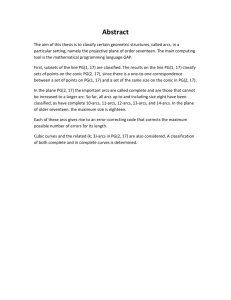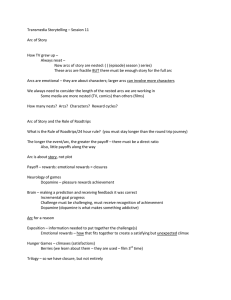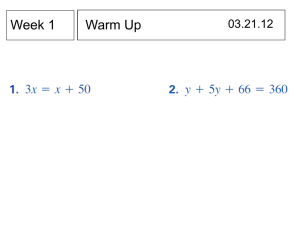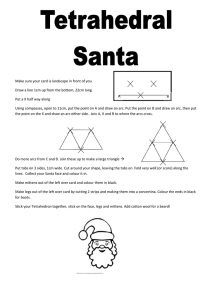On the incompleteness of (k, n)-arcs in Desarguesian planes of
advertisement
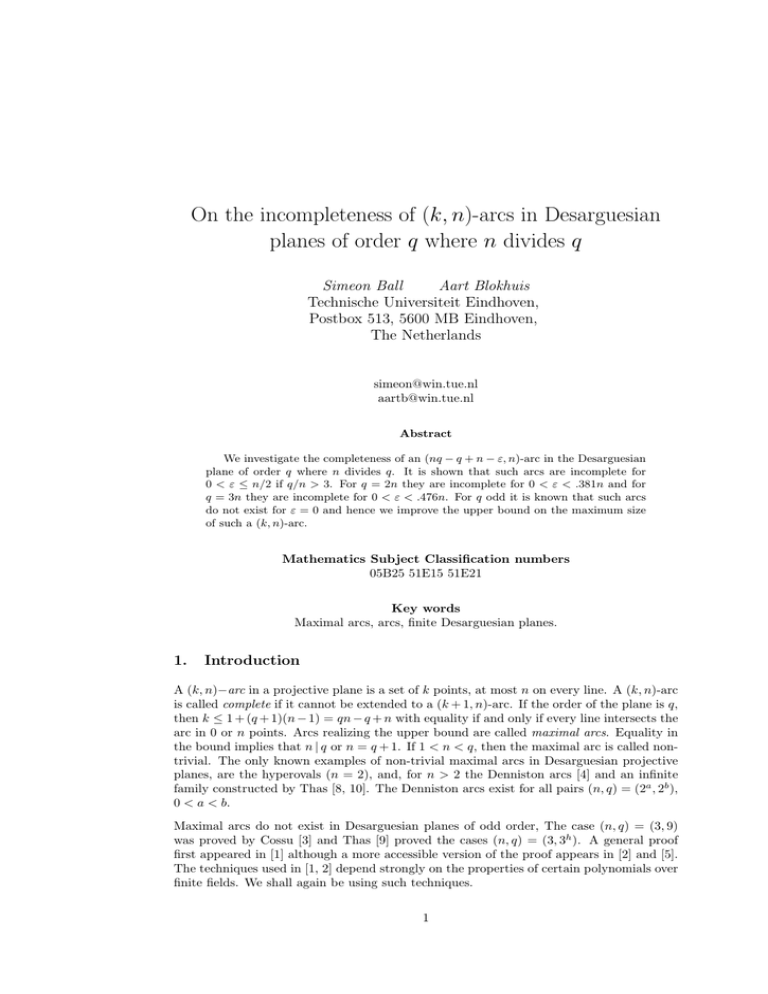
On the incompleteness of (k, n)-arcs in Desarguesian
planes of order q where n divides q
Simeon Ball
Aart Blokhuis
Technische Universiteit Eindhoven,
Postbox 513, 5600 MB Eindhoven,
The Netherlands
simeon@win.tue.nl
aartb@win.tue.nl
Abstract
We investigate the completeness of an (nq − q + n − ε, n)-arc in the Desarguesian
plane of order q where n divides q. It is shown that such arcs are incomplete for
0 < ε ≤ n/2 if q/n > 3. For q = 2n they are incomplete for 0 < ε < .381n and for
q = 3n they are incomplete for 0 < ε < .476n. For q odd it is known that such arcs
do not exist for ε = 0 and hence we improve the upper bound on the maximum size
of such a (k, n)-arc.
Mathematics Subject Classification numbers
05B25 51E15 51E21
Key words
Maximal arcs, arcs, finite Desarguesian planes.
1.
Introduction
A (k, n)−arc in a projective plane is a set of k points, at most n on every line. A (k, n)-arc
is called complete if it cannot be extended to a (k + 1, n)-arc. If the order of the plane is q,
then k ≤ 1 + (q + 1)(n − 1) = qn − q + n with equality if and only if every line intersects the
arc in 0 or n points. Arcs realizing the upper bound are called maximal arcs. Equality in
the bound implies that n | q or n = q + 1. If 1 < n < q, then the maximal arc is called nontrivial. The only known examples of non-trivial maximal arcs in Desarguesian projective
planes, are the hyperovals (n = 2), and, for n > 2 the Denniston arcs [4] and an infinite
family constructed by Thas [8, 10]. The Denniston arcs exist for all pairs (n, q) = (2a , 2b ),
0 < a < b.
Maximal arcs do not exist in Desarguesian planes of odd order, The case (n, q) = (3, 9)
was proved by Cossu [3] and Thas [9] proved the cases (n, q) = (3, 3h ). A general proof
first appeared in [1] although a more accessible version of the proof appears in [2] and [5].
The techniques used in [1, 2] depend strongly on the properties of certain polynomials over
finite fields. We shall again be using such techniques.
1
BALL & BLOKHUIS : INCOMPLETENESS OF ARCS
In this paper we show that a (nq − q + n − ε, n)-arc in P G(2, q), n < q/3 is incomplete for
0 < ε ≤ n/2 and any such arc can therefore be completed to a maximal arc. For q odd
this implies immediately that the maximal size of a (k, n)-arc, denoted mn (2, q) in other
literature (see [6]), for n|q is less than nq − q + n/2.
At this point we compare our result to the work of Szőnyi [7]. Although his work is still in
progress it is interesting to note the different bounds achieved using different techniques.
His algebraic geometric approach gives a bound on epsilon of cq 1/4 . In other words, a
(nq − q + n − ε, n)-arc is incomplete for ε < cq 1/4 . It follows that for n/2 < cq 1/4 his bound
is better, since we would like ε as large as possible. However, reversing the inequality
clearly implies the opposite.
2.
Some counting and some conclusions
Let B be a (nq − q + n − ε, n)-arc in P G(2, q) where n/2 > ε > 0. Counting the number of
points of B on the lines passing through a point of B we immediately get that a line with
at least one point of B in fact has at least n − ε points. Using this, the standard counting
arguments involving incident (point, line) pairs and (point, point, line) triples gives that
there will be lines missing
(if li denotes
precisely i points,
P BP
P the number of lines containingP
then we can compute
li ,
ili and
i(i − 1)li and it turns out that (i − n)(i − (n −
ε))li > 0, hence l0 > 0), so we can, and will, consider our point set B in the affine plane
AG(2, q).
Define a good point to be a point not in B which lies on exactly q/n external lines. Let G
be the set of good points. Let H be the set of points not in B which are not good, we shall
call such points bad. Our aim is to show that bad points are on no external lines. First
however we wish to get some kind of lower bound on the number of good points. Using
this we then apply some polynomial techniques, which imply the incompleteness property.
Define si to be the number of lines containing n − i points of B, and let si (P ) be the
number of lines through the point P containing n − i points of B. Let S be the set of lines
containing some points of B but less than n points of B. For every point P ∈ B
ε
X
isi (P ) = ε
i=1
and summing this over all points P ∈ B gives
ε
X
i(n − i)si = ε(nq − q + n − ε) ≥ (n − ε)
i=1
For all bad points P ∈ H
ε
X
isi .
i=1
ε
X
isi (P ) ≥ n + ε
i=1
with equality if and only if P is on exactly q/n − 1 external lines. In fact if a point P is
on (exactly) q/n − l external lines then
ε
X
isi (P ) = ln + ε.
i=1
It is clear that
ε
XX
isi (P ) ≥ |H|(n + ε)
P ∈H i=1
2
BALL & BLOKHUIS : INCOMPLETENESS OF ARCS
and we can manipulate the sum on the left as follows:
ε
XX
isi (P ) =
P ∈H i=1
≤
X
X
(n − |l ∩ B|)(|l ∩ H|)
l∈S
(n − |l ∩ B|)(q − n + ε) = (
ε
X
isi )(q − n + ε).
i=1
l∈S
Combining various inequalities we get
|H| ≤ (q − n + ε)(nq − q + n − ε)ε/(n − ε)(n + ε).
Now |G| + |H| + |B| = q 2 and so
|G| + |B| ≥ q 2 − (q − n + ε)(nq − q + n − ε)ε/(n − ε)(n + ε).
In the initial stage we will require the number of good points together with the number of
points in the arc to be more than (n + ε)(q − 1). This will occur when
q 2 − (q − n + ε)(nq − q + n − ε)ε/(n − ε)(n + ε) > (n + ε)(q − 1),
and ignoring some positive terms on the right-hand side and some negative terms on the
left-hand side when
q 2 − (q − n + ε)nqε/(n − ε)(n + ε) > (n + ε)q.
Writing ε = cn and m = q/n this will hold for 0 ≤ c ≤ cm , where cm is the unique zero in
the interval (0, 1) of the cubic c3 /m − c2 − c − 1/m + 1. For m = 2 we get cm > .381, for
m = 3 we get cm > .476 and for m ≥ 4 we have cm > 1/2.
3.
A technical lemma
At several points in the rest of the paper we will make use of the following lemma; it will
be referred to simply as the lemma. Here q, n and ε are as before.
Lemma 3.1 Let R ∈ Fq2 [t, x], be of the form
R(t, x) =
q+ε
X
ρj (x)tj
j=0
with ρ0 = 1, and ρj a polynomial of degree at most j(q − 1). Suppose R(t, x0 ) is fully
reducible in Fq2 [t] for all x0 ∈ Fq2 . Let S ∈ Fq2 be the set of points x0 for which we have
a factorization
q/n
ε
X
X
R(t, x0 ) =
ρin (x0 )tin
ρj (x0 )tj ,
i=0
j=0
Suppose for some x1 ∈ Fq2 we have the factorization
q/n−l
R(t, x1 ) =
X
γin tin
i=0
ln+ε
X
j=0
for some l > 0, with ln + ε < |S|/(q − 1). Then x1 ∈ S.
3
δ j tj ,
BALL & BLOKHUIS : INCOMPLETENESS OF ARCS
Proof : For x0 ∈ S and 0 ≤ j < n we have ρin+j (x0 ) = ρin (x0 )ρj (x0 ) and ρj (x0 ) = 0 for
ε < j < n. Since ρin+j has degree at most (in + j)(q − 1) these equations hold identically
for in + j ≤ ln + ε < |S|/(q − 1). It follows that δj = 0 for in + ε < j < (i + 1)n, where
i = 0, 1, . . . , l − 1, and we may write
ln+ε
X
δ j tj =
j=0
l
X
∆i (t)tin ,
i=0
Pε
where ∆i has degree at most ε in t. Let R0 = j=0 ρj (x1 )tj . Then we can successively
solve ∆0 = R0 , ∆1 + γn ∆0 = R0 ρn (x1 ), . . ., ∆l + γn ∆l−1 + . . . + γnl ∆0 = R0 ρln (x1 ) so
we get that all ∆’s are constant multiples (depending on x1 of course) of R0 and it follows
that x1 ∈ S.
4.
Some useful polynomials and their consequences
The points of AG(2, q) can be identified with the elements of GF (q 2 ) in a suitable way, so
that in fact all point sets can be considered as subsets of this field. Note that three points
a, b, c are collinear, precisely when (a − b)q−1 = (a − c)q−1 . If the direction of the line
joining a and b is identified with the number (a − b)q−1 , then a one-to-one correspondence
between the q + 1 directions (or parallel classes) and the different (q + 1)-st roots of unity
in GF (q 2 ) is obtained. Let B, G and H be as they were in the last section but view them
now as subsets of GF (q 2 ).
Let B [−1] = {1/b | b ∈ B \ {0}} and define G [−1] and H[−1] similarly.
Define the polynomials F in two variables and σk in one variable by
F (t, x) :=
Y
q−1
(1 − (1 − bx)
t) =
b∈B
∞
X
(−1)k σk tk
k=0
where σk is the k-th elementary symmetric function of the set of polynomials
{(1 − bx)q−1 | b ∈ B}, a polynomial of degree at most k(q − 1) in x.
Define the formal inverse to F , when viewed as a polynomial in t to be
F −1 (t, x) :=
∞
X
αk tk
k=0
such that F F −1 ≡ 1. It is clear that αk is P
a polynomial in x. Moreover it is a sum of
m
certain terms of the form σi1 σi2 ....σim where j=1 ij = k and therefore has degree at most
k(q − 1) in x.
For x0 ∈ B [−1] we get that F (t, x0 )|(1−tq+1 )n−1 , for in this case every line passing through
the point 1/x0 contains at most n−1 other points of B, so that the multiset {(1/x0 −b)q−1 }
consists of every (q + 1)-st root of unity repeated at most n − 1 times, together with the
element 0. The quotient of this divisibility has degree ε and since this is assumed
Pε to be less
than n (in fact we need only less than q here) we have that the quotient is j=0 αj (x0 )tj .
Consider the equality
ε
X
F (t, x0 )
αj (x0 )tj = (1 − tq+1 )n−1 .
j=0
4
BALL & BLOKHUIS : INCOMPLETENESS OF ARCS
The right-hand side has no non-constant term until q + 1. If we look at the terms of degree
greater than ε yet less than q + 1 we find that
αj (x0 ) = 0
for ε < j < q + 1 whenever x0 ∈ B [−1] .
For x0 ∈ G [−1] ∪ H[−1] we get that F (t, x0 )|(1 − tq+1 )n , for in this case every line passing
through the point 1/x0 contains at most n points of B, so that the multiset {(1/x0 −
b)q−1 |b ∈ B} consists of various (q + 1)-st root of unity repeated at most n times. Define
the quotient of this divisibility to be Q(t, x0 ) where Q has degree q + ε in t and
F (t, x0 )Q(t, x0 ) = (1 − tq+1 )n = 1 − tnq+n .
We can write down an expression for Q(t, x0 ), it is simply
Q(t, x0 ) =
q+ε
X
αj tj .
j=0
By definition Q(t, x0 ) splits into linear factors in t whose (inverse) roots correspond to the
directions of lines through 1/x0 that have less than n points of B, counted with multiplicity.
For example, consider a line through 1/x0 that has direction γ yet contains no points of B.
It follows that (1 − γt)n |Q(t, x0 ). Moreover consider x0 ∈ G [−1] . The corresponding point
to 1/x0 lies on q/n external lines and hence
q/n
ε
X
X
Q(t, x0 ) =
αin tin
αj tj .
i=0
j=0
Note that this equation also holds for x0 ∈ B[−1] since for these points the first factor
reduces to the constant term α0 = 1.
Consider x1 ∈ H[−1] such that 1/x1 corresponds to a point on exactly q/n − 1 external
lines. It follows that
q/n−1
n+ε
X
X
Q(t, x1 ) =
γin tin
δ j tj
i=0
j=0
for some γin and δj . We are now in the position to apply our lemma, with l = 1 and
R = Q. We have B [−1] ∪ G [−1] ⊂ S, so |S| > (n + ε)(q − 1), (here we assume that ε < .381n
if q/n = 2, that ε < .476n if q/n = 3 and ε < n/2 if q/n > 2) and we conclude that x1 ∈ S.
This would imply however that 1/x1 corresponds to a point on q/n external lines since
Q(t, x1 ) has q/n factors repeated n times. In other words, 1/x1 is a good point. Therefore,
all elements of H lie on less than q/n − 1 external lines. In particular if q/n = 2 bad points
are on no external lines. In the remaining part we will therefore take q/n > 2.
In the next section we go back to our counting argument from an earlier section with the
added knowledge that H contains no points on exactly q/n − 1 external lines.
5.
More counting and more polynomials
All points in H are on at most q/n − 2 external lines so we have now that for P ∈ H
ε
X
isi (P ) ≥ 2n + ε.
i=1
5
BALL & BLOKHUIS : INCOMPLETENESS OF ARCS
Continuing the same argument as before with this new bound implies
|G| + |B| ≥ q 2 −
(q − n + ε)(nq − q + n − ε)ε
≥ 0.6q 2 ,
(n − ε)(2n + ε)
where we just use ε ≤ .476n.
Consider again x0 ∈ G [−1] ∪ B [−1] . As before,
q/n
ε
X
X
αj tj
Q(t, x0 ) =
αin tin
j=0
i=0
Consider x1 ∈ H[−1] such that 1/x1 corresponds to a point on exactly q/n − l external
lines, with l < 0.6q/n. It follows that
q/n−l
ln+ε
X
X
Q(t, x1 ) =
γin tin
δ j tj
i=0
j=0
for some γin and δj . We may apply our technical lemma again and conclude as before
that x1 is in fact a good point. Now we have that all points in H are on less than 0.4q/n
external lines. For q/n = 3 it pays to be a bit more precise in our bookkeeping, and in fact
we get that in this case bad points are on no external lines. So from here on we assume
q/n > 3. We return to our counting argument and conclude that for P ∈ H
ε
X
isi (P ) ≥ 0.6(q/n)n + ε = 0.6q + ε.
i=1
Continuing as before we get that |H| < 2nq and hence at least q 2 − 2nq points are either
good or in B. Applying the lemma, now with l = q/n − 3 we get that all points in H are
now on at most 2 external lines, and doing it once more on no external lines.
We have now proven that all points on external lines are good points and, since good points
lie on exactly q/n external lines, the external lines form a dual maximal arc of degree q/n.
The lines in the dual plane that are external to this dual maximal arc are simply the points
B ∪ H in the original plane. The external lines to a maximal arc form a dual maximal arc
and hence B ∪ H is a maximal arc. Note that this implies that the extension of B to a
maximal arc is unique. We have, therefore, proved the following theorem:
Theorem 5.1 Let B be a (nq − q + n − ε, n)-arc in P G(2, q) where n divides q.
1. (q even.) For ε < n/2 and q/n > 2 or ε < .381n and q/n = 2, B can be extended
uniquely to some maximal arc containing nq − q + n points.
2. (q odd.) If q/n > 3 then ε > n/2 and if q/n = 3 then ε > .476n.
References
[1] S. Ball, A. Blokhuis and F. Mazzocca, Maximal arcs in Desarguesian planes of
odd order do not exist, Combinatorica, 17, (1997), 31–41.
[2] S. Ball and A. Blokhuis, An easier proof of the maximal arcs conjecture, Proc.
Amer. Math. Soc., to appear.
6
BALL & BLOKHUIS : INCOMPLETENESS OF ARCS
[3] A. Cossu, Su alcune proprietà dei {k; n}-archi di un piano proiettivo sopra un corpo
finito, Rend. Mat. e Appl., 20, (1961), 271–277.
[4] R. H. F. Denniston, Some maximal arcs in finite projective planes, J. Combin.
Theory, 6, (1969), 317–319.
[5] J. W. P. Hirschfeld, Projective Geometries over Finite Fields, Second Edition,
Clarendon Press, Oxford (1997).
[6] J. W. P. Hirschfeld and L. Storme, The packing problem in statistics, coding
theory and finite projective spaces, Journal of Statistical Planning and Inference, Proceedings of the Bose Memorial Conference (Colorado, June 7–11 1995).
[7] T. Szőnyi, On the embeddability of (k, p)-arcs, manuscript.
[8] J. A. Thas, Construction of maximal arcs and partial geometries, Geom. Dedicata, 3,
(1974), 61–64.
[9] J. A. Thas, Some results concerning {(q + 1)(n − 1); n}−arcs and {(q + 1)(n − 1) +
1; n}−arcs in finite projective planes of order q, J. Combin. Theory Ser. A, 19, (1975),
228–232.
[10] J. A. Thas, Construction of maximal arcs and dual ovals in translation planes, Europ.
J. Combinatorics, 1, (1980), 189–192.
[11] B. J. Wilson, Incompleteness of (nq + n − q − 2, n)-arcs in finite projective planes
of even order, Math. Proc. Cambridge Philos. Soc., 91, (1982), 1–8.
7

